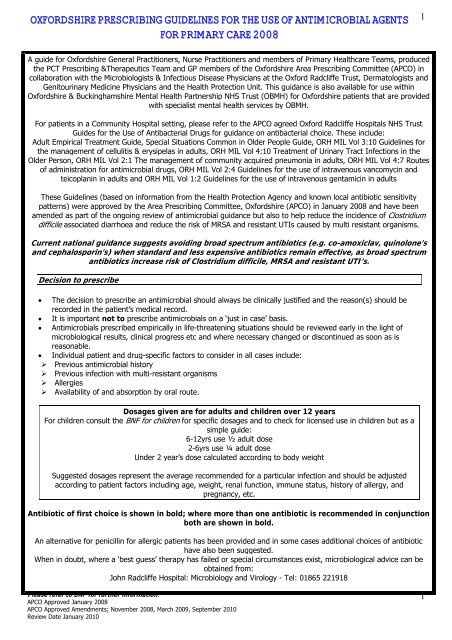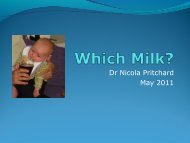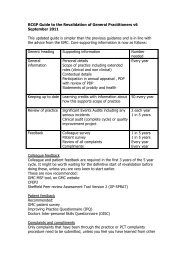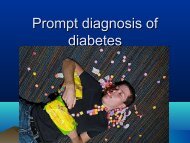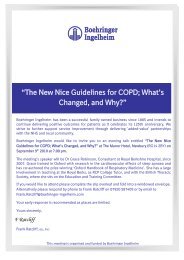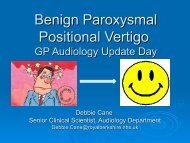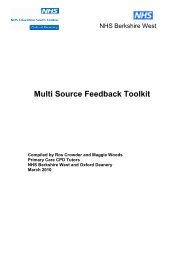Oxfordshire Primary Care Antimicrobial Prescribing Guidelines up ...
Oxfordshire Primary Care Antimicrobial Prescribing Guidelines up ...
Oxfordshire Primary Care Antimicrobial Prescribing Guidelines up ...
Create successful ePaper yourself
Turn your PDF publications into a flip-book with our unique Google optimized e-Paper software.
OXFORDSHIRE PRESCRIBING GUIDELINES FOR THE USE OF ANTIMICROBIAL AGENTS<br />
FOR PRIMARY CARE 2008<br />
1<br />
A guide for <strong>Oxfordshire</strong> General Practitioners, Nurse Practitioners and members of <strong>Primary</strong> Healthcare Teams, produced<br />
the PCT <strong>Prescribing</strong> &Therapeutics Team and GP members of the <strong>Oxfordshire</strong> Area <strong>Prescribing</strong> Committee (APCO) in<br />
collaboration with the Microbiologists & Infectious Disease Physicians at the Oxford Radcliffe Trust, Dermatologists and<br />
Genitourinary Medicine Physicians and the Health Protection Unit. This guidance is also available for use within<br />
<strong>Oxfordshire</strong> & Buckinghamshire Mental Health Partnership NHS Trust (OBMH) for <strong>Oxfordshire</strong> patients that are provided<br />
with specialist mental health services by OBMH.<br />
For patients in a Community Hospital setting, please refer to the APCO agreed Oxford Radcliffe Hospitals NHS Trust<br />
Guides for the Use of Antibacterial Drugs for guidance on antibacterial choice. These include:<br />
Adult Empirical Treatment Guide, Special Situations Common in Older People Guide, ORH MIL Vol 3:10 <strong>Guidelines</strong> for<br />
the management of cellulitis & erysipelas in adults, ORH MIL Vol 4:10 Treatment of Urinary Tract Infections in the<br />
Older Person, ORH MIL Vol 2:1 The management of community acquired pneumonia in adults, ORH MIL Vol 4:7 Routes<br />
of administration for antimicrobial drugs, ORH MIL Vol 2:4 <strong>Guidelines</strong> for the use of intravenous vancomycin and<br />
teicoplanin in adults and ORH MIL Vol 1:2 <strong>Guidelines</strong> for the use of intravenous gentamicin in adults<br />
These <strong>Guidelines</strong> (based on information from the Health Protection Agency and known local antibiotic sensitivity<br />
patterns) were approved by the Area <strong>Prescribing</strong> Committee, <strong>Oxfordshire</strong> (APCO) in January 2008 and have been<br />
amended as part of the ongoing review of antimicrobial guidance but also to help reduce the incidence of Clostridium<br />
difficile associated diarrhoea and reduce the risk of MRSA and resistant UTIs caused by multi resistant organisms.<br />
Current national guidance suggests avoiding broad spectrum antibiotics (e.g. co-amoxiclav, quinolone’s<br />
and cephalosporin’s) when standard and less expensive antibiotics remain effective, as broad spectrum<br />
antibiotics increase risk of Clostridium difficile, MRSA and resistant UTI’s.<br />
Decision to prescribe<br />
• The decision to prescribe an antimicrobial should always be clinically justified and the reason(s) should be<br />
recorded in the patient’s medical record.<br />
• It is important not to prescribe antimicrobials on a ‘just in case’ basis.<br />
• <strong>Antimicrobial</strong>s prescribed empirically in life-threatening situations should be reviewed early in the light of<br />
microbiological results, clinical progress etc and where necessary changed or discontinued as soon as is<br />
reasonable.<br />
• Individual patient and drug-specific factors to consider in all cases include:<br />
‣ Previous antimicrobial history<br />
‣ Previous infection with multi-resistant organisms<br />
‣ Allergies<br />
‣ Availability of and absorption by oral route.<br />
Dosages given are for adults and children over 12 years<br />
For children consult the BNF for children for specific dosages and to check for licensed use in children but as a<br />
simple guide:<br />
6-12yrs use ½ adult dose<br />
2-6yrs use ¼ adult dose<br />
Under 2 year’s dose calculated according to body weight<br />
Suggested dosages represent the average recommended for a particular infection and should be adjusted<br />
according to patient factors including age, weight, renal function, immune status, history of allergy, and<br />
pregnancy, etc.<br />
Antibiotic of first choice is shown in bold; where more than one antibiotic is recommended in conjunction<br />
both are shown in bold.<br />
An alternative for penicillin for allergic patients has been provided and in some cases additional choices of antibiotic<br />
have also been suggested.<br />
When in doubt, where a ‘best guess’ therapy has failed or special circumstances exist, microbiological advice can be<br />
obtained from:<br />
John Radcliffe Hospital: Microbiology and Virology - Tel: 01865 221918<br />
Please refer to BNF for further information.<br />
APCO Approved January 2008<br />
APCO Approved Amendments; November 2008, March 2009, September 2010<br />
Review Date January 2010<br />
1
OXFORDSHIRE PRESCRIBING GUIDELINES FOR THE USE OF ANTIMICROBIAL AGENTS<br />
FOR PRIMARY CARE 2008<br />
2<br />
Aims<br />
• To provide a simple, best guess approach to the treatment of common infections<br />
• To promote the safe, effective and economic use of antibiotics<br />
• To minimise the emergence of bacterial resistance in the community<br />
• To reduce the risk of infection from MRSA, Clostridium difficile and other resistant bacteria<br />
• To maintain the effectiveness of antimicrobial agents in the treatment of infections by reducing the risk of<br />
bacteria developing antimicrobial resistance.<br />
Principles of Treatment<br />
1. This guidance is based on the best available evidence but its application must be modified by professional<br />
judgement.<br />
2. A dose and duration of treatment is suggested. In severe or recurrent cases consider a larger dose or longer<br />
course<br />
3. Treatment of most infections should not exceed 7 days.<br />
4. Prescribe an antibiotic only when there is likely to be a clear clinical benefit.<br />
5. Do not prescribe an antibiotic for viral sore throat, simple coughs and colds.<br />
6. Limit prescribing over the telephone to exceptional cases.<br />
7. Use simple generic antibiotics first whenever possible. Avoid broad spectrum antibiotics (e.g. coamoxiclav,<br />
quinolone’s and cephalosporin’s) when standard and less expensive antibiotics<br />
remain effective, as they increase risk of Clostridium difficile, MRSA and resistant UTI’s.<br />
8. Avoid widespread use of topical antibiotics (especially those agents also available as systemic<br />
preparations).<br />
9. In pregnancy AVOID tetracyclines, aminoglycoside’s, quinolone’s, and high dose metronidazole. Short-term<br />
use of trimethoprim (theoretical risk in first trimester in patients with poor diet, as folate antagonist) or<br />
nitrofurantoin (at term, theoretical risk of neonatal haemolysis) is unlikely to cause problems to the foetus.<br />
10. Clarithromycin is an acceptable alternative in those who are unable to tolerate erythromycin because of side<br />
effects.<br />
*Useful websites include:<br />
http://www.hpa.org.uk/infections/topics_az/primary_care_guidance/menu.htm<br />
http://www.brit-thoracic.org.uk<br />
http://cks.library.nhs.uk/clinical_knowledge<br />
Grading of guidance recommendations<br />
The strength of each recommendation is qualified by a letter in parenthesis.<br />
Study design<br />
Recommendation<br />
Grade<br />
Good recent systematic review of studies A+<br />
One or more rigorous studies, not combined A-<br />
One or more prospective studies B+<br />
One or more retrospective studies B-<br />
Formal combination of expert opinion<br />
C<br />
Informal opinion, other information<br />
D<br />
Please refer to BNF for further information.<br />
APCO Approved January 2008<br />
APCO Approved Amendments; November 2008, March 2009, September 2010<br />
Review Date January 2010<br />
2
OXFORDSHIRE PRESCRIBING GUIDELINES FOR THE USE OF ANTIMICROBIAL AGENTS<br />
FOR PRIMARY CARE 2008<br />
3<br />
ILLNESS /<br />
COMMON<br />
COMMENTS DRUG DOSE DURATION<br />
OF TX<br />
ORGANISM<br />
UPPER RESPIRATORY TRACT INFECTIONS: Consider a delayed antibiotic prescription A-<br />
Influenza<br />
Influenza HPA<br />
Immunisation<br />
against Infectious<br />
Disease 2006<br />
Influenza NICE<br />
Annual vaccination is essential for all those at risk of influenza. For current ‘at risk patients’ please refer to:<br />
http://www.hpa.org.uk/infections/topics_az/influenza/seasonal/flufaq.htm#vacc<br />
The CCDC will issue advice when local surveillance indicates the prevalence of influenza in <strong>Oxfordshire</strong> has reached the<br />
appropriate threshold.<br />
For otherwise healthy adults, antiviral therapy is not recommended.<br />
Treat ‘at risk’ patients, only when influenza A or B is circulating in the community and for oseltamivir only within 48 hours of<br />
onset. At risk include:<br />
• 65 years or over<br />
• Chronic respiratory disease (including COPD and asthma) requiring regular medication (caution in severe asthma/COPD)<br />
• Significant cardiovascular disease (not hypertension),<br />
• Immunocompromised,<br />
• Diabetes mellitus,<br />
• Chronic renal disease and chronic liver disease.<br />
Pharyngitis /<br />
sore throat /<br />
tonsillitis<br />
Clinical<br />
Knowledge<br />
Summaries<br />
SIGN<br />
Gro<strong>up</strong> A<br />
Streptococcus<br />
Patients over 13 years use oseltamivir 75 mg oral capsule BD for 5 days (for OD prophylaxis (10 days) see Influenza NICE )<br />
(Children over 1 year: depending on body weight – refer to BNF for children) .<br />
The majority (over 50%) of sore throats are viral; most patients do not benefit from antibiotics.<br />
Consider a delayed antibiotic strategy and explain soreness will take about 8 days to resolve.<br />
Patients with 3 of 4 Centor criteria (history of fever, purulent tonsils, cervical adenopathy, absence of cough) or history of<br />
otitis media may benefit from antibiotics. A- Antibiotics shorten duration of symptoms by 8 hours. A+<br />
You need to treat 30 children or 145 adults to prevent one case of otitis media. A+<br />
QDS may be more appropriate if severe. D<br />
Avoid amoxicillin / ampicillin if possibility of<br />
glandular fever as maculopapular rash<br />
commonly results, in patients with glandular<br />
fever. This rash is not related to true penicillin<br />
allergy.<br />
phenoxymethylpenicillin<br />
erythromycin<br />
if allergic to penicillin<br />
500 mg BD or<br />
250mg QDS<br />
500 mg BD or<br />
250 mg QDS<br />
(QDS less sideeffects)<br />
10 days<br />
10 days<br />
Oro-dental<br />
Infections<br />
Oral Flora<br />
Consider early antibiotic therapy if history of<br />
valvular heart disease, marked systemic <strong>up</strong>set,<br />
peritonsillar cellulitis or if at an increased risk<br />
from acute infection (e.g. immuno<strong>up</strong>ression)<br />
Antibacterial required only for severe disease<br />
Treat for 3 to 5 days or until symptoms<br />
resolve.<br />
amoxicillin<br />
Consider addition of<br />
metronidazole if severe infection<br />
or failure to respond to<br />
amoxicillin<br />
Dosages of both<br />
can be doubled if<br />
severe.<br />
500mg TDS<br />
400mg TDS<br />
3 - 5 days*<br />
3 - 5 days*<br />
erythromycin<br />
if allergic to penicillin<br />
500 mg BD or<br />
250 mg QDS<br />
(QDS less sideeffects)<br />
3 - 5 days*<br />
*or until<br />
symptoms<br />
resolve<br />
Otitis media<br />
Clinical<br />
Knowledge<br />
Summaries<br />
Pneumococcus<br />
Haem. influenzae<br />
Gro<strong>up</strong> A<br />
Streptococcus<br />
Viruses account for over 50% of these<br />
infections.<br />
Cases resolve in 80% without<br />
antibiotics. A+<br />
Poor outcome unlikely if no vomiting or<br />
temp 2y and seven<br />
6-24month olds to get pain relief in one<br />
at 2-7 days. A+B+<br />
amoxicillin<br />
erythromycin<br />
if allergic to penicillin<br />
500mg TDS<br />
500 mg BD or<br />
250 mg QDS<br />
(QDS less sideeffects)<br />
3 days*<br />
3 days*<br />
* Standing<br />
Medical Advisory<br />
Committee<br />
guidelines<br />
suggest 3 days.<br />
In otitis media,<br />
the relapse rate<br />
is slightly higher<br />
at 10 days with<br />
a 3-day course<br />
but long-term<br />
outcomes are<br />
similar. A+.<br />
Please refer to BNF for further information.<br />
APCO Approved January 2008<br />
APCO Approved Amendments; November 2008, March 2009, September 2010<br />
Review Date January 2010<br />
3
OXFORDSHIRE PRESCRIBING GUIDELINES FOR THE USE OF ANTIMICROBIAL AGENTS<br />
FOR PRIMARY CARE 2008<br />
4<br />
ILLNESS /<br />
COMMON<br />
ORGANISM<br />
Otitis externa<br />
Colonising<br />
organisms<br />
Staph aureus<br />
If Colonising organisms<br />
If Staph aureus<br />
COMMENTS DRUG DOSE DURATION<br />
OF TX<br />
Aural toilet ± aluminium acetate<br />
or steroid drops soaked on<br />
ribbon gauze or sponge wick<br />
flucloxacillin<br />
500mg QDS<br />
5 days<br />
Clinical<br />
Knowledge<br />
Summaries<br />
erythromycin<br />
if allergic to penicillin<br />
500 mg BD or<br />
250 mg QDS<br />
(QDS less sideeffects)<br />
5 days<br />
Sinusitis<br />
acute or chronic<br />
Clinical<br />
Knowledge<br />
Summaries<br />
Pneumococcus<br />
Haem. influenzae<br />
Gro<strong>up</strong> A<br />
Streptococcus<br />
PLUS<br />
Anaerobes<br />
Viruses account for over 50% of these<br />
infections.<br />
Symptomatic benefit of antibiotics is<br />
small - 69% resolve without antibiotics; and<br />
84% resolve with antibiotics. A+<br />
Reserve antibiotics for severe B+ or<br />
symptoms (>10 days).<br />
Cochrane review concludes that amoxicillin<br />
and phenoxymethylpenicillin have similar<br />
efficacy to the other recommended antibiotics.<br />
If failure to respond use another first line<br />
antibiotic then second line<br />
LOWER RESPIRATORY TRACT INFECTIONS<br />
amoxicillin<br />
erythromycin<br />
if allergic to penicillin<br />
or<br />
oxytetracycline (NB: Not<br />
recommended for children or in<br />
pregnancy)<br />
2 nd line: Consider<br />
Addition of metronidazole<br />
or changing to<br />
co-amoxiclav if failure to<br />
respond to 1 st line therapy<br />
500mg TDS<br />
500 mg BD or<br />
250 mg QDS<br />
(QDS less sideeffects)<br />
250mg QDS<br />
400mg TDS<br />
375mg TDS<br />
Note: Avoid tetracyclines in pregnancy. Low doses of penicillins are more likely to select out resistance. The quinolones<br />
ciprofloxacin and ofloxacin have poor activity against pneumococci. However, they do have use in PROVEN pseudomonal infections.<br />
Systematic reviews indicate antibiotics have amoxicillin<br />
250 - 500 mg TDS 5 days<br />
Acute bronchitis marginal benefits in otherwise healthy<br />
Clinical<br />
adults. A+<br />
250 - 500 mg QDS 5 days<br />
Knowledge Patient leaflets can reduce antibiotic use. B+<br />
Summaries<br />
Pneumococcus<br />
Haem. influenzae<br />
If no response in 48 hours of antibiotic<br />
therapy consider admission or add<br />
erythromycin first line or a tetracycline C to<br />
cover ‘atypical’ organisms.<br />
oxytetracycline (NB: Not<br />
recommended for children)<br />
Or<br />
erythromycin<br />
if allergic to penicillin<br />
500 mg BD or<br />
250 mg QDS<br />
(QDS less sideeffects)<br />
7 days<br />
7 days<br />
7 days<br />
7 days<br />
7 days<br />
5 days<br />
Acute<br />
exacerbation of<br />
COPD<br />
NICE<br />
Clinical<br />
Knowledge<br />
Summaries<br />
Pneumococcus<br />
Haem. influenzae<br />
Viruses may account for over 50% of<br />
these infections. (30% viral, 30-50%<br />
bacterial, rest undetermined)<br />
Antibiotics not indicated in absence of<br />
purulent/mucopurulent sputum. B+ Most<br />
valuable if increased dyspnoea and increased<br />
purulent sputum. B+ In penicillin allergy use<br />
erythromycin if tetracycline contraindicated<br />
If no response in 48 hours of antibiotic<br />
therapy consider admission or add<br />
erythromycin first line or a tetracycline C to<br />
cover ‘atypical’ organisms.<br />
amoxicillin<br />
oxytetracycline (NB: Not<br />
recommended for children)<br />
Or<br />
erythromycin<br />
if allergic to penicillin<br />
250 - 500 mg TDS<br />
250 - 500 mg QDS<br />
500 mg BD or<br />
250 mg QDS<br />
(QDS less sideeffects)<br />
5 days<br />
5 days<br />
5 days<br />
Please refer to BNF for further information.<br />
APCO Approved January 2008<br />
APCO Approved Amendments; November 2008, March 2009, September 2010<br />
Review Date January 2010<br />
4
OXFORDSHIRE PRESCRIBING GUIDELINES FOR THE USE OF ANTIMICROBIAL AGENTS<br />
FOR PRIMARY CARE 2008<br />
5<br />
Communityacquired<br />
pneumonia -<br />
treatment in the<br />
community<br />
BTS<br />
BTS pdf<br />
Pneumococcus<br />
Mycoplasma,<br />
Chlamydia<br />
Legionella<br />
Start antibiotics immediately. B-<br />
If no response in 48 hours consider admission<br />
or add erythromycin first line or a tetracycline C<br />
to cover ‘atypical’ organisms.<br />
In severely ill give parenteral benzylpenicillin<br />
before admission C and seek risk factors for<br />
Legionella and Staph. aureus infection. D<br />
Post Influenza: Seek specialist advice<br />
amoxicillin<br />
oxytetracycline (NB: Not<br />
recommended for children)<br />
Or<br />
erythromycin<br />
500 mg TDS<br />
500 mg QDS<br />
500 mg QDS<br />
7 - 10 days<br />
7 - 10 days<br />
7 - 10 days<br />
Number of days<br />
treatment is<br />
dependant on<br />
severity<br />
Please refer to BNF for further information.<br />
APCO Approved January 2008<br />
APCO Approved Amendments; November 2008, March 2009, September 2010<br />
Review Date January 2010<br />
5
OXFORDSHIRE PRESCRIBING GUIDELINES FOR THE USE OF ANTIMICROBIAL AGENTS<br />
FOR PRIMARY CARE 2008<br />
6<br />
ILLNESS COMMENTS DRUG DOSE DURATION<br />
OF TX<br />
URINARY TRACT INFECTIONS Clinical Knowledge Summaries<br />
See local <strong>Oxfordshire</strong> Guideline http://www.oxfordshire.nhs.uk/docs/prescribing/12-4-march2003.pdf<br />
Note: Amoxicillin resistance is common, therefore ONLY use if culture confirms susceptibility. In the elderly (>65 years), do not treat asymptomatic<br />
bacteriuria; it occurs in 25% of women and 10% of men and is not associated with increased morbidity +<br />
In the presence of a catheter, antibiotics will not eradicate bacteriuria; only treat if systemically unwell or pyelonephritis likely.<br />
Females: Cystitis<br />
/ Uncomplicated<br />
UTI i.e. no fever<br />
or flank pain<br />
E Coli<br />
Females:<br />
Pyelonephritis<br />
E Coli<br />
Recurrent UTI<br />
women ≥ 3/yr<br />
Females<br />
Pregnancy:<br />
Cystitis<br />
E Coli<br />
Use urine dipstick to guide decision making as<br />
opposed to over ruling clinical judgement.<br />
There is NO need for culture unless failure of<br />
empirical therapy or relapse/recurrent<br />
infection<br />
There is less relapse with trimethoprim than<br />
cephalosporins A-<br />
Community multi-resistant E. coli with<br />
Extended-spectrum Beta-lactamase enzymes<br />
(ESBLs) are increasing so perform culture in all<br />
treatment failures.<br />
ESBLs are multi-resistant but remain sensitive<br />
to nitrofurantoin<br />
Send MSU for culture.<br />
Post coital prophylaxis is as effective as<br />
prophylaxis taken nightly. Prophylactic doses<br />
‣ Avoid trimethoprim in 1 st trimester of<br />
pregnancy.<br />
‣ However short-term use of trimethoprim<br />
or nitrofurantoin in pregnancy is unlikely<br />
to cause problems to the foetus. B+<br />
trimethoprim B+<br />
nitrofurantoin A-<br />
OR<br />
nitrofurantoin MR A-<br />
3 rd line<br />
cefalexin<br />
Forth line - depends on<br />
susceptibility of organism<br />
isolated<br />
co-amoxiclav (prescribe as coamoxiclav<br />
375mg with<br />
amoxicillin 250mg)<br />
OR<br />
ciprofloxacin A-<br />
OR if sensitivities known<br />
trimethoprim<br />
nitrofurantoin<br />
OR trimethoprim<br />
cefalexin<br />
OR<br />
nitrofurantoin<br />
OR<br />
nitrofurantoin MR<br />
OR<br />
200 mg BD<br />
50mg QDS<br />
100mg BD<br />
500mg TDS<br />
500/125 mg TDS<br />
500 mg BD<br />
200 mg BD<br />
50 mg<br />
100 mg<br />
500mg TDS<br />
50mg QDS<br />
100mg BD<br />
3 days B+<br />
3 days B+<br />
3 days B+<br />
3 days B+<br />
14 days A-<br />
7 days<br />
14 days<br />
Stat post coital<br />
OR OD at night<br />
7 days<br />
7 days<br />
7 days<br />
Send MSU for culture<br />
If sensitivities known:<br />
Females<br />
Pregnancy:<br />
Pyelonephritis<br />
E Coli<br />
Check MSU 7 days after treatment<br />
Send MSU for culture<br />
Check MSU 7 days after treatment<br />
trimethoprim<br />
OR<br />
amoxicillin<br />
cefalexin<br />
OR<br />
co-amoxiclav (prescribe as coamoxiclav<br />
375mg with<br />
amoxicillin 250mg)<br />
200 mg BD<br />
500mg TDS<br />
500mg TDS<br />
500/125 mg TDS<br />
7 days<br />
7 days -<br />
10 – 14 days<br />
10 – 14 days<br />
If sensitivities known:<br />
Children, Adult<br />
Males, Relapse<br />
or Recurrent<br />
Infection in<br />
Non Pregnant<br />
Females<br />
Send MSU for culture<br />
Check MSU 7 days after treatment completed<br />
and investigate underlying cause<br />
Ciprofloxacin is not suitable for children<br />
trimethoprim<br />
OR<br />
amoxicillin<br />
co-amoxiclav (prescribe as coamoxiclav<br />
375mg with<br />
amoxicillin 250mg)<br />
ciprofloxacin<br />
OR<br />
cefalexin<br />
200 mg BD<br />
500mg TDS<br />
500/125 mg TDS<br />
500mg BD<br />
500mg TDS<br />
10 – 14 days<br />
10 – 14 days<br />
10 – 14 days<br />
10 -14 days<br />
10 - 14 days<br />
E Coli<br />
NOTE:<br />
Doses stated are ADULT DOSES.<br />
FOR CHILDREN: Please refer to the Children’s<br />
BNF for appropriate doses.<br />
If sensitivities known:<br />
trimethoprim<br />
OR<br />
amoxicillin<br />
200 mg BD<br />
500mg TDS<br />
10 – 14 days<br />
10 – 14 days<br />
Please refer to BNF for further information.<br />
APCO Approved January 2008<br />
APCO Approved Amendments; November 2008, March 2009, September 2010<br />
Review Date January 2010<br />
6
OXFORDSHIRE PRESCRIBING GUIDELINES FOR THE USE OF ANTIMICROBIAL AGENTS<br />
FOR PRIMARY CARE 2008<br />
7<br />
GENITAL TRACT INFECTIONS - UK NATIONAL GUIDELINES<br />
Note: Patients with risk factors for STI should be considered for referral to GUM, especially if recurrent infections.<br />
Risk factors are: age
OXFORDSHIRE PRESCRIBING GUIDELINES FOR THE USE OF ANTIMICROBIAL AGENTS<br />
FOR PRIMARY CARE 2008<br />
8<br />
ILLNESS COMMENTS DRUG DOSE DURATION<br />
OF TX<br />
Epididymoorchitis<br />
(35yrs or low risk<br />
of STI)<br />
Cause usually STI<br />
For epididymo-orchitis most probably due to<br />
enteric organisms:<br />
E.coli<br />
Refer/discuss with GUM<br />
for contact tracing &<br />
partner treatment<br />
doxycycline<br />
ofloxacin<br />
ciprofloxacin<br />
trimethoprim<br />
GASTRO-INTESTINAL TRACT INFECTIONS<br />
For further information about investigation and clinical and public health management see local guide<br />
Management of Acute Diarrhoea In <strong>Primary</strong> <strong>Care</strong> – <strong>Prescribing</strong> Points 19.12<br />
<strong>Oxfordshire</strong> PCT Referral <strong>Guidelines</strong>: Gastroenterology<br />
Clostridium difficile<br />
Infection (CDI)<br />
DH & HPA<br />
STOP unnecessary antibiotics and/or<br />
PPIs B+ .<br />
If continued antibiotic treatment necessary<br />
seek micro/ID advice.<br />
Admit if severe: T >38.5; WCC >15, rising<br />
creatinine or signs/symptoms of severe colitis C<br />
1 st /2 nd episode (whether<br />
recurrence or relapse)<br />
vancomycin<br />
3 rd episode/or severe<br />
disease<br />
Seek micro/ID advice<br />
100mg BD<br />
200mg BD<br />
500mg BD<br />
200mg BD<br />
125mg QDS po<br />
14 days<br />
for 14 days<br />
14 days<br />
14 days<br />
14 days C<br />
If patient is unable to take capsules give<br />
metronidazole suspension.<br />
metronidazole<br />
400mg TDS po<br />
14 days C<br />
Gastroenteritis<br />
Clinical Knowledge<br />
Summaries<br />
Infective diarrhoea<br />
Clinical Knowledge<br />
Summaries<br />
Traveller’s diarrhoea<br />
Clinical Knowledge<br />
Summaries<br />
Most self-limiting and antibiotic treatment is rarely required. Antibiotic therapy is not usually indicated as it only<br />
reduces diarrhoea by 1-2 days B+ and can cause antibiotic resistance or increased incidence of C difficile. B+<br />
Empirical treatment with ciprofloxacin* may be given to those with dysenteric symptoms and considered in the elderly and<br />
others at high risk of serious complications of gastroenteritis if systemically unwell (see ‘High Risk’ patients in <strong>Prescribing</strong><br />
Points 19.12). Empirical antibiotic therapy for children is not recommended.<br />
Suspected Campylobacter<br />
erythromycin<br />
250mg QDS<br />
3 – 5 days<br />
Suspected Salmonella / Shigella<br />
Only consider empirical therapy if the<br />
patient is systemically unwell. Usually<br />
wait for culture result to reassess<br />
whether antibiotics are indicated.<br />
ciprofloxacin*<br />
500mg BD<br />
3 – 5 days<br />
Only consider standby antibiotics for remote areas or people at high-risk of severe illness with travellers’ diarrhoea C .<br />
If standby treatment appropriate give: ciprofloxacin* 500 mg twice a day for 3 days (private Rx) C, B+ .<br />
If quinolone resistance high (e.g. south Asia) and standby treatment appropriate: consider azithromycin 1g stat (private Rx).<br />
*Not licensed for use in children – only give on microbiologist/infectious disease physician advice<br />
Please refer to BNF for further information.<br />
APCO Approved January 2008<br />
APCO Approved Amendments; November 2008, March 2009, September 2010<br />
Review Date January 2010<br />
8
OXFORDSHIRE PRESCRIBING GUIDELINES FOR THE USE OF ANTIMICROBIAL AGENTS<br />
FOR PRIMARY CARE 2008<br />
9<br />
Eradication of<br />
Helicobacter pylori<br />
NICE<br />
Eradication is beneficial in DU, GU and low<br />
grade MALTOMA, but NOT in GORD. A<br />
In NUD, 8% of patients benefit.<br />
Triple treatment attains >85% eradication. A+<br />
For initial treatment, a week triple therapy<br />
regimen that comprises a PPI, clarithromycin<br />
and either amoxicillin or metronidazole can<br />
be used.<br />
Do not use clarithromycin or metronidazole<br />
if used in the past year for any infection. C<br />
Resistance to amoxicillin is rare.<br />
If a patient has been treated with<br />
metronidazole for other infections, a<br />
regimen containing a PPI, amoxicillin and<br />
clarithromycin is preferred for initial therapy.<br />
If a patient has been treated with<br />
clarithromycin for other infections, a<br />
regimen containing a PPI, amoxicillin and<br />
metronidazole is preferred for initial therapy.<br />
Triple therapy should therefore be chosen<br />
dependant on whether the patient has had<br />
previous exposure to either metronidazole or<br />
clarithromycin.<br />
First line A+<br />
omeprazole capsules<br />
PLUS<br />
amoxicillin<br />
AND<br />
clarithromycin<br />
OR<br />
omeprazole capsules<br />
PLUS<br />
amoxicillin<br />
AND<br />
metronidazole<br />
For patients allergic to<br />
penicillin:<br />
omeprazole capsules<br />
PLUS<br />
metronidazole<br />
AND<br />
clarithromycin<br />
For 2 nd line treatment, if no<br />
previous exposure to the<br />
alternate regimen / penicillin<br />
allergy consider the<br />
alternate regimen for 14<br />
days, otherwise contact the<br />
Microbiology Dept on 01865<br />
221918 or the<br />
Gastroenterology Dept on<br />
01865 220959 for advice.<br />
20 mg BD<br />
1g BD<br />
500mg BD<br />
20 mg BD<br />
1g BD<br />
400mg BD<br />
20 mg BD<br />
400mg BD<br />
500mg BD<br />
All for<br />
7 days A<br />
ILLNESS COMMENTS DRUG DOSE DURATION OF TX<br />
Threadworms<br />
Clinical Knowledge<br />
Summaries<br />
Giardia<br />
Other Worms<br />
Treat household contacts. Advise morning<br />
shower/baths and hand hygiene.<br />
Use piperazine in children under 2<br />
years.<br />
Paediatric doses are usually given as once<br />
daily doses for three days. Please refer to<br />
Children’s BNF for specific doses for specific<br />
ages<br />
As per BNF / Children’s BNF <strong>Guidelines</strong><br />
mebendazole<br />
piperazine<br />
100 mg<br />
1-6 yrs: 5ml<br />
spoonful<br />
3-12 months:<br />
2.5ml spoon<br />
Stat<br />
Stat, repeat after 2<br />
weeks<br />
Stat, repeat after 2<br />
weeks<br />
metronidazole 400mg TDS 7 -10 days<br />
SKIN / SOFT TISSUE INFECTIONS<br />
ILLNESS COMMENTS DRUG DOSE DURATION OF TX<br />
Impetigo<br />
Clinical<br />
Knowledge<br />
Summaries<br />
Gro<strong>up</strong> A<br />
Streptococcus<br />
Staph aureus<br />
As resistance is increasing topical<br />
antibiotics are not recommended<br />
MRSA: Minor skin infections may respond to<br />
oxytetracycline<br />
Reserve M<strong>up</strong>irocin for confirmed MRSA<br />
ONLY.<br />
A Cochrane review (search date to January<br />
2003) of interventions for the treatment of<br />
impetigo found little evidence on the<br />
effectiveness of disinfecting / antiseptic<br />
however the role of antiseptics and<br />
potassium permanganate soaks could be<br />
considered as adjuvant therapy in severe or<br />
resistant cases.<br />
flucloxacillin<br />
If penicillin allergic:<br />
erythromycin<br />
oxytetracycine (NB: Not for<br />
children under 12 years or in<br />
pregnancy)<br />
M<strong>up</strong>irocin<br />
Oral 500 mg QDS<br />
Oral 500 mg QDS<br />
250mg – 500mg<br />
QDS<br />
Topically QDS<br />
5 - 7 days<br />
5 - 7 days<br />
5 – 7 days<br />
5 days<br />
Please refer to BNF for further information.<br />
APCO Approved January 2008<br />
APCO Approved Amendments; November 2008, March 2009, September 2010<br />
Review Date January 2010<br />
9
OXFORDSHIRE PRESCRIBING GUIDELINES FOR THE USE OF ANTIMICROBIAL AGENTS<br />
FOR PRIMARY CARE 2008<br />
10<br />
Cellulitis<br />
Gro<strong>up</strong> A<br />
Streptococcus<br />
Staph aureus<br />
Clinical Knowledge<br />
Summaries<br />
If patient afebrile & healthy: use<br />
flucloxacillin alone.<br />
If febrile and ill or fails to resolve, consider<br />
admission for IV treatment<br />
Note: Control of oedema and elevation of<br />
the affected limb is a key part of treatment.<br />
Dermatitis is often misdiagnosed as cellulitis:<br />
Review diagnosis if it appears bilateral<br />
Recurrent cellulitis in lymphoedema is a<br />
common problem: Each episode of cellulitis<br />
causes more lymphatic damage: Consider<br />
prophylactic phenoxymethylpenicillin 250mg<br />
BD for 6 months.<br />
flucloxacillin<br />
If penicillin allergic:<br />
erythromycin alone<br />
For facial cellulitis C<br />
co-amoxiclav<br />
500 mg QDS<br />
500 mg QDS<br />
500/125 mg TDS<br />
7 – 14 days<br />
7 – 14 days<br />
7 - 14 days<br />
Duration of therapy<br />
depends on clinical<br />
response<br />
If cellulitis in the presence of an ulcer, treat<br />
as for leg ulcers (section below) and use coamoxiclav<br />
Per-anal Infection in children – Consider<br />
Gro<strong>up</strong> A Strep<br />
Mastitis<br />
Gro<strong>up</strong> A<br />
Streptococcus<br />
Staph aureus<br />
Vulvitis in pre-pubertal girls: Consider Gro<strong>up</strong><br />
A Strep, Strep pneumoniae, Haem.<br />
Influenzae<br />
flucloxacillin<br />
If penicillin allergic:<br />
erythromycin alone<br />
500 mg QDS<br />
500 mg QDS<br />
7 – 14 days<br />
7 – 14 days<br />
Duration of therapy<br />
depends on clinical<br />
response<br />
Please refer to BNF for further information.<br />
APCO Approved January 2008<br />
APCO Approved Amendments; November 2008, March 2009, September 2010<br />
Review Date January 2010<br />
10
OXFORDSHIRE PRESCRIBING GUIDELINES FOR THE USE OF ANTIMICROBIAL AGENTS<br />
FOR PRIMARY CARE 2008<br />
11<br />
ILLNESS COMMENTS DRUG DOSE DURATION OF<br />
TX<br />
Eczema<br />
Clinical<br />
Knowledge<br />
Summaries<br />
Leg ulcers<br />
Clinical<br />
Knowledge<br />
Summaries<br />
There is a lack of evidence that these topical corticosteroids combined with topical antibiotics are more effective than topical<br />
corticosteroids alone, and there is a possibility that widespread use may contribute to the development of bacterial resistance.<br />
Bacteria will always be present. Antibiotics do not improve healing. A+ Culture swabs and antibiotics are only indicated if<br />
there is evidence of clinical infection such as inflammation/redness/cellulitis; increased pain; purulent exudate; rapid<br />
deterioration of ulcer or pyrexia. If these signs are present: Treat as for Cellulitis (see section above).<br />
Diabetic leg ulcer<br />
Refer for specialist opinion if<br />
severe infection.<br />
co-amoxiclav (prescribe as<br />
co-amoxiclav 375mg with<br />
amoxicillin 250mg)<br />
500/125 mg TDS 7 days<br />
and review<br />
Animal bite<br />
Pasteurella<br />
multocida<br />
+ anaerobes<br />
Human bite<br />
Anaerobes<br />
Staph.aureus<br />
Gro<strong>up</strong> A<br />
Streptococcus<br />
Acne<br />
Proprionibacterium<br />
acnes<br />
Clinical<br />
Knowledge<br />
Summaries<br />
Surgical toilet most<br />
important.<br />
Assess tetanus and rabies<br />
risk.<br />
Antibiotic prophylaxis advised<br />
for – puncture wound; bite<br />
involving hand, foot, face,<br />
joint, tendon, ligament;<br />
immunocompromised,<br />
diabetics, elderly, asplenic<br />
Antibiotic prophylaxis<br />
advised.<br />
Surgical toilet most<br />
important.<br />
Antibiotic prophylaxis advised<br />
for – puncture wound; bite<br />
involving hand, foot, face,<br />
joint, tendon, ligament;<br />
immunocompromised,<br />
diabetics, elderly, asplenic<br />
Antibiotic prophylaxis<br />
advised.<br />
Assess HIV/hepatitis B & C<br />
risk: The Health Protection<br />
Unit and ‘On Call Public<br />
Health team are available to<br />
help on risk assessment.<br />
Phone: 01865 226858.<br />
Note: Propionibacteria strains<br />
resistant to erythromycin are<br />
becoming widespread and<br />
this may explain poor<br />
response.<br />
* 3-6 months of treatment<br />
may be too early to assess<br />
for response.<br />
co-amoxiclav B-<br />
(prescribe as co-amoxiclav<br />
375mg with amoxicillin<br />
250mg)<br />
If penicillin allergic:<br />
metronidazole PLUS<br />
oxytetracycline (animal)<br />
and review at 24 & 48 hrs<br />
co-amoxiclav B-<br />
(prescribe as co-amoxiclav<br />
375mg with amoxicillin<br />
250mg)<br />
If penicillin allergic:<br />
metronidazole PLUS<br />
erythromycin (human)<br />
and review at 24 & 48 hrs<br />
Topical applications i.e.<br />
benzoyl peroxide + / -<br />
retinoid for noninflammatory<br />
comedonal<br />
disease.<br />
If significant inflammatory<br />
disease, consider adding in<br />
an antibiotic<br />
1 st Line: oxytetracycline<br />
500/125 mg TDS<br />
200 – 400mg TDS<br />
250 - 500 mg QDS<br />
500/125 mg TDS<br />
200-400 mg TDS<br />
250-500 mg QDS<br />
500mg bd<br />
7 days<br />
7 days<br />
7 days<br />
7 days<br />
7 days<br />
7 days<br />
3 - 6 months or longer*<br />
Note: If acne is scarring<br />
significantly, make specialist<br />
referral for consideration of<br />
isotretinoin (Specialist<br />
prescribing only).<br />
2 nd Line if no response after 3<br />
months:<br />
lymecycline<br />
or<br />
erythromycin<br />
408mg once daily<br />
500mg bd<br />
3 - 6 months or longer*<br />
3 - 6 months or longer*<br />
Please refer to BNF for further information.<br />
APCO Approved January 2008<br />
APCO Approved Amendments; November 2008, March 2009, September 2010<br />
Review Date January 2010<br />
11
OXFORDSHIRE PRESCRIBING GUIDELINES FOR THE USE OF ANTIMICROBIAL AGENTS<br />
FOR PRIMARY CARE 2008<br />
12<br />
ILLNESS COMMENTS DRUG DOSE DURATION OF<br />
TX<br />
Conjunctivitis<br />
Clinical<br />
Knowledge<br />
Summaries<br />
Pneumococcus<br />
Haem.influenzae<br />
Staph.aureus<br />
Chlamydia<br />
(neonates)<br />
Scabies<br />
Sarcoptes scabiei<br />
Clinical<br />
Knowledge<br />
Summaries<br />
Viruses account for over 50% of these<br />
infections.<br />
Most bacterial infections are selflimiting<br />
(64% resolve on placebo A+ ). They<br />
are usually unilateral with yellow-white<br />
mucopurulent discharge.<br />
Fusidic acid has less Gram-negative activity<br />
In neonates Chlamydia may be implicated<br />
which will require systemic erythromycin<br />
12.5mg / kg QDS for 2-3 weeks +/- topical<br />
erythromycin (also treat mother and<br />
partner)<br />
Treat whole body including scalp, face, neck,<br />
ears, under nails.<br />
Treat all household and sexual contacts even<br />
if not showing itching symptoms.<br />
Permethrin: Wash off after 8 – 12 hours<br />
If hands are washed with soap within 8<br />
hours they should be re-treated<br />
chloramphenicol<br />
0.5% drops<br />
fusidic acid 1% gel<br />
permethrin A+<br />
malathion (unlicensed use)<br />
TWO HOURLY<br />
reducing to QDS<br />
BD<br />
5% cream<br />
0.5% Aqueous Liquid<br />
All for 48 hours after<br />
resolution<br />
2 applications as per<br />
BNF instructions one<br />
week apart<br />
2 applications as per<br />
BNF instructions one<br />
week apart<br />
Malation: Wash off after 24 hours<br />
If hands are washed with soap within 24<br />
hours they should be re-treated<br />
Head Lice<br />
Pediculus capitis<br />
Clinical<br />
Knowledge<br />
Summaries<br />
Treatment is not necessary unless a<br />
live louse is found<br />
Offer a choice of treatment strategies: an<br />
insecticide, wet combing, or dimeticone<br />
lotion: No treatment is 100% effective.<br />
Choice of treatment depends on the<br />
preference of the individual/parent and on<br />
the treatment history.<br />
For a woman who is pregnant or<br />
breastfeeding, offer treatment with wet<br />
combing or dimeticone.<br />
Insecticides and dimeticone are not licensed<br />
for children under 6 months except under<br />
medical s<strong>up</strong>ervision<br />
Do not use insecticide lotion more than once<br />
for three consecutive weeks<br />
Consider dimeticone lotion<br />
4% especially if resistance to<br />
insecticides.<br />
If using insecticides use<br />
lotions, not shampoo<br />
Wet combing: Combining<br />
the above or a sole<br />
treatment of regular wet<br />
combing with conditioner<br />
Rub lotion onto dry<br />
hair and scalp. Allow<br />
to remain on for 8<br />
hours or overnight.<br />
Remove by washing<br />
after 8 hours<br />
Rub lotion into dry hair<br />
and allow to dry<br />
naturally.<br />
Remove by washing<br />
after 12 hours<br />
Treatment involves<br />
methodically combing<br />
wet hair with a finetoothed<br />
comb to<br />
remove lice.<br />
This is undertaken for<br />
four sessions over 2<br />
weeks.<br />
Wet combing should<br />
be continued until no<br />
full-grown lice have<br />
been seen for 3<br />
consecutive sessions.<br />
2 applications one<br />
week apart<br />
2 applications one<br />
week apart<br />
Fungal /<br />
Dermatophyte<br />
infection of the<br />
proximal<br />
fingernail or<br />
toenail<br />
For children seek<br />
advice<br />
Take nail clippings: Start therapy only if<br />
infection is confirmed by laboratory.<br />
Idiosyncratic liver reactions occur rarely with<br />
terbinafine.<br />
For infections with yeasts and nondermatophyte<br />
moulds and Candida use<br />
itraconazole. C<br />
Itraconazole can also be used for<br />
dermatophytes<br />
terbinafine A-<br />
itraconazole<br />
250 mg OD<br />
fingernails<br />
toenails<br />
200 mg BD<br />
fingernails<br />
toenails<br />
6 – 12 weeks<br />
3 – 6 months<br />
7 days monthly<br />
2 courses<br />
7 days monthly<br />
3 courses<br />
Please refer to BNF for further information.<br />
APCO Approved January 2008<br />
APCO Approved Amendments; November 2008, March 2009, September 2010<br />
Review Date January 2010<br />
12
OXFORDSHIRE PRESCRIBING GUIDELINES FOR THE USE OF ANTIMICROBIAL AGENTS<br />
FOR PRIMARY CARE 2008<br />
13<br />
ILLNESS COMMENTS DRUG DOSE DURATION OF<br />
TX<br />
Fungal /<br />
Dermatophyte<br />
infection of the<br />
skin<br />
Athletes Foot/ Fungal Groin Infection /<br />
Ringworm<br />
Topical 1% terbinafine<br />
(Not children) A+<br />
OD - BD<br />
1-2x/daily<br />
1 week A+<br />
4 – 6 weeks A+<br />
Dermatophytes<br />
Clinical<br />
Knowledge<br />
Summaries<br />
Treatment: 1 week terbinafine is as effective<br />
as 4 weeks azole. A- If intractable consider<br />
oral itraconazole.<br />
Note: Terbinafine cream is not licensed for<br />
use in children and an imidazole should be<br />
used 1 st line.<br />
Topical combinations (+ corticosteroid<br />
should not be needed and avoided if at all<br />
possible<br />
1% imidazole e.g.<br />
clotrimazole / miconazole<br />
(Not nystatin as is NOT<br />
effective against<br />
dermatophytes ) A+<br />
Scalp<br />
Dermatophytes<br />
Scalp Ringworm<br />
Hair plucks for culture are essential as<br />
choice of treatment is species dependent: M<br />
canis responds well to griseofulvin whereas<br />
T tonsurans (greater recent prevalence<br />
especially in cities and black children)<br />
responds well to terbinafine. Dermatologists<br />
advise initiating treatment with terbinafine<br />
and being prepared to switch treatment to<br />
griseofulvin if culture shows M canis.<br />
Terbinafine is not licensed for use in children<br />
but the BNF for Children does suggest doses<br />
for children over 1 year old (see below).<br />
Adults: terbinafine oral<br />
Children: griseofulvin oral*<br />
Selenium shampoo* in<br />
severe cases may be<br />
appropriate in addition. This<br />
reduces the risk of spreading<br />
the infection to others.<br />
Also ketoconazole shampoo<br />
and povidone iodine<br />
See BNF<br />
See Children’s BNF for<br />
dose<br />
Twice a week<br />
4 weeks<br />
6 – 8 weeks<br />
2 - 4 weeks<br />
Bodyweight 10–20 kg, 62.5 mg once daily;<br />
Bodyweight 21–40 kg, 125 mg once daily;<br />
Bodyweight over 40 kg, 250 mg once daily.<br />
This would allow shorter treatment courses<br />
than with griseofulvin therapy and<br />
terbinafine tablets may be crushed<br />
Pityriasis<br />
versicolor<br />
Caused by an overgrowth of Pityrosporum<br />
orbiculare (Malassezia furfur).<br />
Most adults have Pityrosporum orbiculare on<br />
their skin; however, in a few people its<br />
presence results in a harmless skin disease.<br />
Pityrosporum orbiculare also plays a role in<br />
the development of seborrhoeic dermatitis<br />
(including cradle cap).<br />
Poorly responsive to terbinafine and<br />
completely unresponsive to nystatin and<br />
griseofulvin.<br />
1 st Line:<br />
Selenium shampoo<br />
OR<br />
Ketoconazole shampoo<br />
Apply DAILY to the<br />
affected area that has<br />
been previously<br />
wetted. Leave for 30<br />
minutes.<br />
NB: This time period is<br />
recommended by the<br />
BNF however 30<br />
minutes may provoke<br />
irritant dermatitis and<br />
this may be avoided<br />
by reducing time to 5-<br />
10 minutes<br />
After using as a wash,<br />
allow to rest for 5<br />
minutes on wetted<br />
skin<br />
7 days<br />
5 days<br />
3 rd Line: itraconazole (only in<br />
severe unresponsive cases<br />
due to benefit risk ratio)<br />
200mg daily<br />
7 days<br />
Intertrigo<br />
Candida albicans<br />
Clinical<br />
Knowledge<br />
Summaries<br />
Combination preparations containing<br />
corticosteroids e.g. trimovate cream should<br />
only be applied if there is marked<br />
inflammation. They should be applied<br />
sparingly to avoid skin atrophy on areas of<br />
thin skin (e.g. facial areas) and for a<br />
maximum of 1 week<br />
clotrimazole 1% Cream<br />
Please refer to BNF for further information.<br />
APCO Approved January 2008<br />
APCO Approved Amendments; November 2008, March 2009, September 2010<br />
Review Date January 2010<br />
13
OXFORDSHIRE PRESCRIBING GUIDELINES FOR THE USE OF ANTIMICROBIAL AGENTS<br />
FOR PRIMARY CARE 2008<br />
14<br />
VIRAL INFECTIONS<br />
ILLNESS COMMENTS DRUG DOSE DURATION OF<br />
TX<br />
Herpes Simplex<br />
First attack non-genital and recurrent oral<br />
infection.<br />
First attack genital<br />
Topical, over the counter<br />
aciclovir can be used for<br />
mild oral herpes (cold<br />
sores).<br />
aciclovir<br />
200mg FIVE x daily<br />
5 days<br />
famciclovir<br />
valaciclovir<br />
250mg TDS<br />
500mg BD<br />
5 days<br />
5 days<br />
Recurrent attacks of genital herpes -<br />
intermittent therapy: Specific treatments<br />
usually not beneficial as recurrences are<br />
self-limiting and generally cause minor<br />
symptoms.<br />
Recurrent attacks of genital herpes -<br />
s<strong>up</strong>pressive therapy: Only indicated if at<br />
least six recurrences per annum.<br />
aciclovir<br />
famciclovir<br />
valaciclovir<br />
400 mg BD<br />
250 mg BD<br />
500 mg OD<br />
Interr<strong>up</strong>t therapy<br />
every 6-12 months for<br />
reassessment of<br />
disease.<br />
Varicella zoster/<br />
Chicken pox<br />
Clinical<br />
Knowledge<br />
Summaries<br />
&<br />
Herpes zoster/<br />
shingles<br />
Clinical<br />
Knowledge<br />
Summaries<br />
If pregnant seek advice re treatment and<br />
prophylaxis<br />
Chicken pox: Clinical value of antivirals<br />
minimal unless immunocompromised, severe<br />
pain, adult, on steroids, secondary<br />
household case AND treatment started<br />
50 yrs if
OXFORDSHIRE PRESCRIBING GUIDELINES FOR THE USE OF ANTIMICROBIAL AGENTS<br />
FOR PRIMARY CARE 2008<br />
15<br />
Treatment Advice: CHICKENPOX<br />
Immunocompromised Patients: (i.e. see Immunisation against Infectious Disease 2006 – for definition of immunocompromised see Section 7).<br />
‣ Refer urgently to a specialist for intravenous Aciclovir.<br />
Immunocompetent Patients:<br />
‣ Treatment is indicated for all persons over 15 years of age (NB: Chickenpox in adults – Clinical management).<br />
‣ Treatment should start as soon as possible, preferably within 24 hours and certainly within 72 hours of the onset of the rash.<br />
‣ Treat adults for 7 days with Aciclovir 800mg 5 x daily or Valaciclovir 1 gm tds or Famciclovir 500 mg tds.<br />
‣ Valaciclovir and Famciclovir are not yet licensed for the treatment of chicken pox, or for use in children, but their use is endorsed by the Infectious<br />
Disease Physicians in Oxford.<br />
‣ Pregnant women may have more serious disease and the benefits of treatment should be balanced against any potential harm to the foetus. (NB:<br />
Chickenpox in adults – Clinical management).<br />
‣ Chickenpox in pregnancy should be treated with Aciclovir 800 mg 5 times daily for 7 days. There is no evidence so far that Aciclovir causes<br />
congenital abnormalities in humans.<br />
‣ Additional risk factors for chicken pox pneumonitis include smoking, chronic lung disease, underlying immunos<strong>up</strong>pression and > 36 weeks<br />
gestation.<br />
‣ Symptoms/signs of more severe chicken pox include respiratory symptoms, haemorrhagic rash, bleeding, densely cropping vesicles, any<br />
neurological changes, and persisting fever with new vesicles er<strong>up</strong>ting more than 6 days after onset.<br />
‣ Individuals with additional risk factors or symptoms/signs of more severe disease should be referred to the local infectious diseases unit for<br />
consideration of iv Aciclovir.<br />
‣ These management guidelines also apply to pregnant women who develop Chickenpox despite being given VZIG.<br />
Children and neonates:<br />
‣ Treatment is indicated for all children with conditions predisposing to serious disease (including those taking oral steroids for ≥14 days, chronic or<br />
severe skin disease, asthma or other cardiopulmonary disease, diabetes, or other chronic illnesses).<br />
‣ Children who require treatment and neonates who develop chicken pox should be referred urgently to the local paediatric department for advice<br />
and treatment.<br />
Treatment Advice: SHINGLES<br />
Immunocompromised: (i.e. see Immunisation against Infectious Disease 2006 – for definition of immunocompromised see Section 7).<br />
‣ Refer to specialist as intravenous therapy may be required.<br />
Immunocompetent including pregnancy:<br />
‣ Refer all patients with eye involvement to an Ophthalmologist.<br />
‣ Treat all patients > 50 years old with Aciclovir 800 mg 5 times daily, Famciclovir 250 mg tds or 750 mg once daily, or Valaciclovir 1 g tds for 7<br />
days. Commence within 72 hours of onset of rash or <strong>up</strong> to one week after onset for ophthalmic zoster.<br />
Prophylaxis Advice: High Risk Contacts of patients with Chickenpox or Shingles<br />
High risk contacts are patients without a definite history of Chickenpox or Shingles and a negative test for varicella antibody, and who have had a<br />
significant contact with Chickenpox or Shingles (Immunisation against Infectious Disease 2006) and are at high risk of serious disease.<br />
These include:<br />
1. Immunocompromised patients (see Immunisation against Infectious Disease 2006 )<br />
2. Pregnant women.<br />
3. Neonates of mothers who develop Chickenpox between 7 days before and 7 days after delivery.<br />
4. Neonates within 7 days of birth where the mother is non immune.<br />
Contact the Virology SpR/Consultant 01865-221918 or for specific advice, to arrange antibody testing and for s<strong>up</strong>plies of VZIG.<br />
If patient is eligible for varicella-zoster immune globulin (VZIG) this will prescribed by the Virology SpR/consultant. Give varicella-zoster immune globulin<br />
(VZIG) 250 mg (1 vial) to 1000mg (4 vials) intramuscularly depending on age. Give preferably within 96 hours of contact, but may be efficacious <strong>up</strong> to<br />
10 days post exposure. VZIG does not prevent infection but may reduce severity.<br />
HEPATITIS B<br />
‣ All patients with chronic infection (HbsAg+ve for more than 6 months) should be referred for assessment and consideration of treatment by a<br />
hepatologist.<br />
‣ Contact Follow Up has a significant role to play. Household and sexual contacts of HbSAg+ve patients should be offered HBV vaccine and advice<br />
on minimising risk of spread. Further guidance is available from the Health Protection Unit on 01865 226858.<br />
HEPATITIS C<br />
‣ Patients who are both hepatitis C antibody and Hepatitis C RNA positive should be referred for assessment and consideration of treatment by a<br />
hepatologist.<br />
Please refer to BNF for further information.<br />
APCO Approved January 2008<br />
APCO Approved Amendments; November 2008, March 2009, September 2010<br />
Review Date January 2010<br />
15
OXFORDSHIRE PRESCRIBING GUIDELINES FOR THE USE OF ANTIMICROBIAL AGENTS<br />
FOR PRIMARY CARE 2008<br />
16<br />
MENINGITIS<br />
Suspected<br />
meningococcal<br />
disease or<br />
meningococcal<br />
sepsis or infection<br />
in a known<br />
asplenic patient<br />
HPA<br />
Meningococcus<br />
Pneumococcus<br />
Transfer all patients to hospital<br />
immediately.<br />
Administer benzylpenicillin prior to admission,<br />
unless history of life threatening reaction to<br />
penicillin. B- . Ideally administer IV but IM if a<br />
vein cannot be found.<br />
Cefotaxime is an alternative in penicillin<br />
allergy.<br />
Chloramphenicol is an alternative if history of<br />
anaphylaxis to penicillin or to cephalosporins<br />
IV or IM benzylpenicillin<br />
Adults & children<br />
10 yr and over:<br />
1200 mg<br />
Children 1 - 9 yr:<br />
600 mg<br />
Children
OXFORDSHIRE PRESCRIBING GUIDELINES FOR THE USE OF ANTIMICROBIAL AGENTS<br />
FOR PRIMARY CARE 2008<br />
17<br />
Please refer to BNF for further information.<br />
APCO Approved January 2008<br />
APCO Approved Amendments; November 2008, March 2009, September 2010<br />
Review Date January 2010<br />
17


